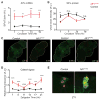A Conserved Circadian Function for the Neurofibromatosis 1 Gene
- PMID: 29590612
- PMCID: PMC5898822
- DOI: 10.1016/j.celrep.2018.03.014
A Conserved Circadian Function for the Neurofibromatosis 1 Gene
Abstract
Loss of the Neurofibromatosis 1 (Nf1) protein, neurofibromin, in Drosophila disrupts circadian rhythms of locomotor activity without impairing central clock function, suggesting effects downstream of the clock. However, the relevant cellular mechanisms are not known. Leveraging the discovery of output circuits for locomotor rhythms, we dissected cellular actions of neurofibromin in recently identified substrates. Herein, we show that neurofibromin affects the levels and cycling of calcium in multiple circadian peptidergic neurons. A prominent site of action is the pars intercerebralis (PI), the fly equivalent of the hypothalamus, with cell-autonomous effects of Nf1 in PI cells that secrete DH44. Nf1 interacts genetically with peptide signaling to affect circadian behavior. We extended these studies to mammals to demonstrate that mouse astrocytes exhibit a 24-hr rhythm of calcium levels, which is also attenuated by lack of neurofibromin. These findings establish a conserved role for neurofibromin in intracellular signaling rhythms within the nervous system.
Keywords: Drosophila; circadian rhythms; cycling of calcium; mouse astrocytes; neurofibromatosis 1; peptide signaling.
Copyright © 2018 The Authors. Published by Elsevier Inc. All rights reserved.
Conflict of interest statement
The authors declare no competing interests.
Figures




References
-
- Balsalobre A, Brown SA, Marcacci L, Tronche F, Kellendonk C, Reichardt HM, Schütz G, Schibler U. Resetting of circadian time in peripheral tissues by glucocorticoid signaling. Science. 2000;289:2344–2347. - PubMed
Publication types
MeSH terms
Substances
Grants and funding
LinkOut - more resources
Full Text Sources
Other Literature Sources
Molecular Biology Databases
Research Materials
Miscellaneous

